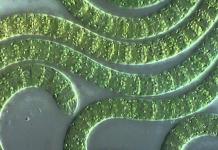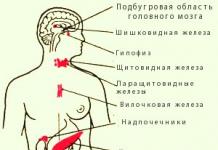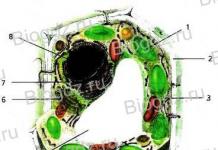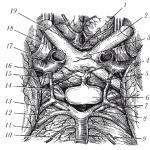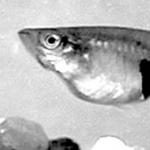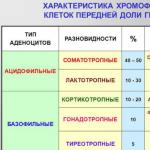Endocrine glands include glands that do not have specialized excretory ducts and secrete their secretions directly into the blood.. The secretion of the endocrine glands are physiologically active substances - hormones. Carried out by hormones humoral regulation of the physiological state of the body. But among the endocrine glands there are glands that perform double function- are glands of internal secretion and external secretion, as they have specialized excretory ducts. TO mixed glands relate pancreas(synthesizes food enzymes, which enter the duodenum as part of pancreatic juice) and gonads.
Composition of the endocrine system
Hypothalamus located under the cavity of the diencephalon. The hypothalamus consists of three groups of nuclei: front, average And back. The presence of extensive nerve and vascular connections with pituitary gland is the basis of existence hypothalamic-pituitary system. The nuclei of the hypothalamus are located subcortical centers, controlling the activity of the autonomic nervous system. The hypothalamus is
the highest center for the regulation of endocrine functions(Fig. 1). It combines nervous and endocrine regulatory mechanisms into a single neuroendocrine system, having a direct effect on the endocrine glands through the nerve pathways or through the pituitary gland (Fig. 2).
Pituitary hormones
|
Front share |
Follitropin (follicle stimulating) |
Causes maturation of follicles in the ovaries in females and spermatogenesis in males |
|
Lutropin (luteinizing) |
In females it stimulates the secretion of estrogen and progesterone, the formation of the corpus luteum, and in males - the secretion of testosterone |
|
|
Prolactin |
Stimulates the development of mammary glands and lactation, stimulates the growth of internal organs, the secretion of the corpus luteum |
|
|
Thyrotropin |
Controls the development and function of the thyroid gland and regulates the biosynthesis and secretion of thyroid hormones into the blood |
|
|
Growth hormone (somatotropin) |
It has a wide range of biological effects: enhances the biosynthesis of protein, DNA, RNA, glycogen, promotes the mobilization of fats from storage and the breakdown of higher fatty acids and glucose in tissues. Regulates growth processes: with hypofunction - dwarfism, with hyperfunction - gigantism |
|
|
Adrenocorticotropic |
Enhances the synthesis of adrenal steroid hormones |
|
|
Rear share |
Vasopressin |
Stimulates the contraction of vascular smooth muscles: regulates water metabolism, providing a powerful antidiuretic effect - stimulates the reverse flow of water through the membranes of the renal tubules. Controls the osmotic pressure of blood plasma |
|
Oxytocin |
The main biological effect in mammals is associated with stimulation of contraction of the smooth muscles of the uterus during childbirth and contraction of muscle fibers located around the alveoli of the mammary glands, causing milk secretion |
Rice. 1. Actual (black arrows) and expected (broken arrows) pathways of distribution and direction of influence of neurohormones produced by neurosecretory cells of the hypothalamus, as well as tropic hormones (white arrows): 1 - neurosecretory cell of the hypothalamus; 2 - III ventricle; 3 - funnel bay; 4 - median elevation; 5 - infundibular part of the neurohypophysis; 6 - main posterior part of the neurohypophysis; 7 - tubular part of the anterior pituitary gland; 8 - intermediate lobe of the pituitary gland; 9 - anterior lobe of the pituitary gland; 10 - portal vessels of the pituitary gland; 11 - thyroid gland; 12 - mammary gland; 13 - pancreas; 14 - blood vessels; 15 - adrenal gland; 16 - kidney; 17 - uterus; 18 - ovary; TSH, STH, ACTH and GSH are thyroid-, somato-, adrenocortico- and gonadotropic hormones, respectively.

Rice. 2. Pituitary gland (bottom view): 1 - anterior cerebral artery; 2 - optic nerve; 3 - visual chiasm; 4 - middle cerebral artery; 5 - funnel; 6 - pituitary gland; 7 - posterior cerebral artery; 8 - oculomotor nerve; 9 - basilar artery; 10 - bridge; 11 - artery of the labyrinth; 12 - superior cerebellar artery; 13 - cerebral peduncle; 14 - posterior communicating artery; 15 - pituitary artery; 16 - gray tubercle; 17 - internal carotid artery; 18 - olfactory tract; 19 - anterior communicating artery
Vasopressin And oxytocin the hormones of the posterior lobe of the pituitary gland are conditionally classified as they are synthesized in the hypothalamus, then enter the posterior pituitary gland along axons and only here they enter the blood. Diseases of the posterior lobe of the pituitary gland affect only the action of vasopressin.
Thyroid (Fig. 3). Primary hormone thyroxine. Main functions: stimulation of oxidative processes, regulation of water, protein, fat, carbohydrate and mineral metabolism, growth and development of the body, affects the functions of the central nervous system and higher nervous activity. At insufficient function in childhood, occurs cretinism(stunted growth, mental and sexual development). At hypofunction an adult develops myxedema. At hyperfunction arises Graves' disease(enlargement of the gland, increased excitability of the nervous system, bulging eyes). If there is a lack of iodine, people get sick goiter. For normal operation it is required iodine.

Rice. 3.Thyroid gland (front view): 1 - hyoid bone; 2 - thyrohyoid membrane; 3 - pyramidal process of the thyroid gland; 4, 7 - left and right lobes; 5 - trachea; 6 - isthmus; 8 - cricoid cartilage; 9 - thyroid cartilage
Thymus (Fig. 4). Primary hormone thymosin, involved in the regulation of neuromuscular transmission, carbohydrate metabolism, and calcium metabolism.
Pineal gland produces a hormone melatonin, which inhibits the action of gonadotropic hormones. Secretion changes depending on light: light suppresses melatonin synthesis. After removal, premature puberty occurs.

Rice. 4.Thymus gland, or thymus: 1 - lobule of the thymus gland; 2 - left lung; 3 - thymus gland (left lobe); 4 - pericardium; 5 - diaphragm; 6, 8 - cut line of the mediastinal pleura; 7 - thymus gland (right lobe); 9 - superior vena cava; 10 - right lung; 11 - subclavian vein; 12 - subclavian artery; 13 - internal jugular vein; 14 - trachea; 15 - left common carotid artery
Adrenal glands (Fig. 5) are located near the upper pole of each kidney. Consist of a cortex and medulla.

Rice. 5.Left adrenal gland (front view): 1 - adrenal gland; 2 - left adrenal vein; 3 - inferior suprarenal artery; 4 - renal artery; 5 - kidney; 6 - ureter; 7 - renal vein; 8 - inferior vena cava; 9 - aorta; 10 - inferior phrenic artery; 11 - middle adrenal artery; 12 - superior adrenal arteries
Adrenal hormones
|
Cortical layer |
Steroid: cortisone, corticosterone |
Affect the metabolism of carbohydrates, proteins, fats, stimulate the synthesis of glycogen from glucose, have the ability to inhibit the development of inflammatory processes, suppress the synthesis of antibodies |
|
Sex hormones |
Causes the development of secondary sexual characteristics. With hyperfunction, the synthesis of hormones increases, especially sex hormones, while secondary sexual characteristics change, for example, women develop a beard and mustache |
|
|
Cerebrallayer |
Adrenalin |
Increases systolic volume, accelerates heart rate, dilates coronary vessels and constricts skin vessels, increases blood flow in the liver, skeletal muscles and brain, increases blood sugar levels, enhances the breakdown of fats. Its action is similar to that of the sympathetic nervous system. Acts on the hypothalamus, causing the formation of adrenocorticotropic hormone |
|
Norepinephrine |
performs the functions of a mediator in the transmission of excitation in synapses. slows heart rate, reduces minute volume |
Pancreas. Produces two main hormones: glucagon And insulin. Glucagon helps convert liver glycogen into glucose, resulting in an increase in blood sugar levels. Insulin increases the permeability of cell membranes to glucose, which favors its breakdown in tissues, glycogen deposition and a decrease in blood sugar. At hypofunction the disease develops - diabetes. The pancreas is a mixed secretion gland. In addition to hormones, this gland produces pancreatic juice, which is involved in digestion. And since pancreatic juice enters the intestine (duodenum) through special excretory ducts, the pancreas also belongs to the exocrine glands.
Sex glands are also mixed secretion glands.
Sex hormones
The regulation of the physiological functions of the body is carried out using two systems - nervous and humoral. In the body they act in concert. Nervous regulation occurs quickly, in a split second, while humoral regulation occurs slowly. This type of regulation is limited by the speed of blood movement through the vessels (0.005-0.5 m/s). Nervous and humoral regulation are closely related to each other and carry out a single neurohumoral regulation. The central nervous system, including its highest section - the cerebral cortex, regulates the functions of the endocrine glands. This is done by transmitting nerve impulses directly to organs and tissues. Humoral regulation involves the regulating influence of biologically active substances carried by blood, lymph, and tissue fluid.
Glands that do not have excretory ducts and secrete their secretions (hormones) directly into the tissue fluid and blood are called endocrine(Fig. 193).
The process of production and release of active substances by endocrine glands is called internal secretion, and the substances are called hormones.
Hormones- chemical compounds with high biological activity, in small doses, give a significant physiological effect. Based on their chemical composition, they are distinguished: 1) steroid hormones; 2) proteins and peptides; 3) derivatives of amino acids.
Hormones are characterized by:
1) distant action. The organs and systems on which hormones act are located far from the place of their formation in the endocrine glands;
2) strict specificity of action. The reaction of organs and tissues to hormones is strictly specific. The specificity of the action of hormones is ensured by the presence of receptor molecules in cells. Only organ cells have receptors for the corresponding hormone.
Rice. 193.Location of endocrine glands (diagram)1 - pineal body;2 - pituitary gland; 3 - thyroid and parathyroid glands;4 - thymus gland (thymus);5 - adrenal gland; 6 - islet part of the pancreas;7 - intrasecretory part of the testicles (in men);8 - intrasecretory part of the ovary (in women).
on-targets, capable of reading chemically encoded information due to this;
3) high biological activity. Hormones are produced by endocrine glands in very small quantities.
Hormones are involved in the regulation and integration of all body functions. They contribute to the body’s adaptation to changing conditions of the external and internal environment and restore the altered balance of the internal environment.
The endocrine glands have different locations, but they are closely related to each other. Violation of the function of one leads to changes in the activity of others. A certain level of hormones is required for the body to function. The lack of one or another hormone indicates a decrease in activity (hypofunction) of this gland, excess - about increased activity (hyperfunction).
With hypo- and hyperfunction of the glands, various endocrine diseases occur.
The endocrine glands are abundantly supplied with blood and lymphatic vessels. The fibers of the autonomic nervous system are suitable for them.
Endocrine glands are divided into dependent and independent from the anterior lobe pituitary gland
To the glands dependent on the pituitary gland include thyroid gland cortical substance of the adrenal glands gonads. The relationship between the anterior lobe of the pituitary gland and these glands is based on the type of direct and feedback connections.
Tropic hormonesthe anterior lobe of the pituitary gland activates the activity of the glands. Gland hormones, acting on the anterior lobe of the pituitary gland, inhibit the formation and release of the corresponding hormone.
TO independent of the anterior lobe pituitary gland include parathyroid glands, pineal gland, pancreatic islets(islets of Langerhans of the pancreas), adrenal medulla, paraganglia.
The highest center for the regulation of endocrine functions is hypothalamus(division of the diencephalon). It unites non-
regulating and endocrine mechanisms of regulation into the general neuroendocrine system. The hypothalamus forms a single functional complex with the pituitary gland. The hypothalamus contains neurons of the usual type and neurosecretory cells. Both types of cells produce protein secretions and mediators. In neurosecretory cells, protein synthesis predominates, and neurosecretion is released into the blood. Thus, the nerve impulse is converted into a neurohumoral one.
Pituitary
Pituitary(brain appendage) - a small gland weighing 0.5-0.7 g. Located in the pituitary fossa of the sella turcica of the sphenoid bone. Through the hole in the diaphragm of the sella, the pituitary gland is connected to the infundibulum of the hypothalamus of the diencephalon. The pituitary gland consists of three lobes: front(adenohypophysis), intermediate And rear(neurohypophysis).
IN anterior lobe The pituitary gland produces a number of hormones: somatotropic, thyrotropic, gonadotropic, adrenocorticotropic and others.
Somatotropicthe hormone controls the growth of bones, muscles, organs, regulates metabolic processes in the body.
At hyperfunction occurs in childhood gigantism(Fig. 194), in an adult - acromegaly(enlargement of individual parts of the body: arms, legs, nose, etc.) (Fig. 195). At hypofunction in childhood a person remains dwarf Pituitary dwarfs have normal mental development and correct body proportions (Fig. 194). Hypofunction in adults causes changes in metabolism, which leads to either general obesity or severe weight loss.
Thyroid-stimulating hormone controls the function thyroid gland, affects its development and hormone production.
Adrenocorticotropic hormone regulates functions cortical substances adrenal glands

Rice. 194.Gigantism. The boys are the same age (14 years old). On the left is a pituitary dwarf - height 100 cm; on the right - pituitary giant - height 187 cm; in the center - a normal boy - height 148 cm.

Rice. 195.Patient with acromegaly. Overgrowth of the lower jaw, nose, hands and feet.
TO gonadotropic hormones include follicle-stimulating(promotes the growth of germ cells), luteinizing(increases the formation of sex hormones and the growth of the corpus luteum), luteotropic (promotes the formation of the corpus luteum and the synthesis of progesterone), prolactin(increases milk production by the mammary glands).
Intermediate part the anterior pituitary gland secretes hormones melanocytotropin, regulating the synthesis of melanin pigment, and lipotropin, activating fat metabolism.
Posterior pituitary gland (neurohypophysis) is formed by nervous tissue and does not synthesize hormones. Biologically active substances are transported to the posterior lobe of the pituitary gland oxytocin And vasopressin. They are produced by the nuclei of the hypothalamus, accumulate in the pituitary gland and are released into the blood. Vasopressin has a vasoconstrictor and antidiuretic effect.
Oxytocinacts on the smooth muscles of the uterus, enhancing its contractions at the end of pregnancy, and stimulates milk secretion.
Thyroid
Thyroid located on the neck in front of the larynx. It has two lobes and an isthmus. The weight of the gland in an adult is 20-30 g. The gland is covered on the outside with a connecting capsule, which divides the organ into lobules.
Slicesconsist of vesicles (follicles), which are structural and functional units. The thyroid gland produces iodine-rich hormones thyroxine And triiodothyronine. Their main function is to stimulate oxidative processes in the cell. Hormones affect water, protein, carbohydrate, fat, mineral metabolism, growth, development and differentiation of tissues. They affect the functions of the central nervous system and higher nervous activity.
Hormone thyrocalcitonin participates in the exchange of calcium and phosphorus, reducing the calcium content in the blood and the reabsorption of calcium from the bones.

Rice. 196.Graves' disease, characterized by exophthalmos. The patient before surgery (left) and after surgery (right).
At hyperfunction thyroid gland occurs Graves' disease(enlarged thyroid gland, increased excitability of the nervous system, basal metabolism, bulging eyes (exophthalmos), decreased body weight) (Fig. 196).
At hypofunction of the gland occurs in childhood cretinism(stunted growth, mental and sexual development). With hypofunction, an adult develops myxedema(decreased basal metabolism, obesity, apathy, decreased body temperature, mucous tissue swelling).
At iodine deficiency people suffer in water endemic goiter(secreting tissue grows in the thyroid gland).
Parathyroid glands
Parathyroid glands (upper and lower) are located on the posterior surface of the thyroid lobes. Their number can vary from 2 to 8. The total mass of the parathyroid gland in an adult is from 0.2-0.35 g. The epithelial cells of these glands produce parathyroid hormone, involved in the metabolism of calcium and phosphorus in the body.
It promotes the release of calcium and phosphorus ions from bones into the blood. Parathyroid hormone enhances the reabsorption of calcium by the kidneys, reducing the excretion of calcium in the urine and increasing its content in the blood.
Adrenal glands
Adrenal glands- paired organs located retroperitoneally directly above the upper poles of the kidneys. The mass of one adrenal gland in an adult is about 12-13 g. They consist of two layers: outdoor(cortical) and internal(cerebral).
IN cortex three groups of hormones are produced: glucocorticoids, mineralocorticoids And sex hormones.
Glucocorticoids (hydrocortisone, corticosterone and etc.) affect the metabolism of carbohydrates, proteins, fats, stimulate the synthesis of glycogen from glucose, and have an anti-inflammatory effect. Glucocorticoids ensure the body's adaptation to emergency conditions.
Mineralocorticoids (aldosterone, etc.) regulate the exchange of sodium and potassium, acting on the kidneys. Aldosterone enhances the reabsorption of sodium in the renal tubules, enhances the release of potassium, participates in the regulation of water-salt metabolism, blood vessel tone, and helps increase blood pressure.
Sex hormones (androgens, estrogens, progesterone) ensure the development of secondary sexual characteristics.
At hyperfunction adrenal glands increase the synthesis of hormones, especially sex hormones. At the same time, secondary sexual characteristics change (women develop a beard, mustache, etc.).
At hypofunction develops bronze disease. The skin acquires a bronze color, loss of appetite, increased fatigue, nausea, and vomiting are observed.
Medullaadrenal glands secretes adrenalin And norepinephrine, participating in carbohydrate metabolism and affecting the cardiovascular system.
Adrenalinincreases systolic blood pressure and cardiac output, increases heart rate, and dilates coronary vessels.
Norepinephrinereduces heart rate and cardiac output.
Endocrine part of the pancreas
The endocrine part of the pancreas is represented by islets of Langerhans. The largest number of them is located in the tail of the pancreas. β cells islets produce the hormone insulin, and α cells- glucagon. These hormones have the opposite effect. Insulin promotes the transformation glucose V glycogen, reduces blood sugar levels, enhances carbohydrate metabolism in muscles, etc. Glucagon is involved in the conversion of glycogen into glucose in the liver, resulting in increased blood sugar levels.
D cellssecrete a hormone somatostatin. Somatostatin inhibits the production of growth hormone by the pituitary gland, as well as the release of insulin and glucagon by α- and β-cells.
At insufficient secretion of hormones by the gland develops diabetes. With this disease, tissues do not absorb glucose, its content in the blood and excretion in urine increases.
Endocrine part of the gonads
Sex glands(testis and ovary) produce sex hormones. IN testes male sex hormones are produced - androgens: (testosterone n) and androsterone. Androgens affect embryonic differentiation and development of the genital organs, puberty, spermatogenesis, development of secondary sexual characteristics, and sexual behavior. These hormones stimulate protein synthesis and accelerate tissue growth.
Female sex hormones are synthesized in the ovary - estrogens(folliculin) And progesterone, which is produced by the cells of the corpus luteum. In addition, small amounts of androgens are produced in the ovaries. Estrogens influence the development of the external genitalia, secondary sexual characteristics, growth and development of the musculoskeletal system, ensuring the development of the body according to the female type. Progesterone prepares the uterine mucosa for embryo implantation, affects the development of the placenta and mammary glands, delays the development of new follicles, etc.
Pineal gland
pineal body, or pineal gland of the brain, part of the diencephalon (epithalamus) also performs endocrine functions. The epiphysis is located in the groove between the superior colliculi of the midbrain quadrigeminal. Its mass is about 0.2 g.
The pineal gland secretes a hormone melatonin, inhibiting the action of gonadotropic hormones. The secretion of the pineal gland changes depending on the light: light inhibits the synthesis of melatonin. The influence of light is realized with the participation of the hypothalamus.
The pineal gland regulates the function of the gonads and puberty. After removal of the epiphysis, premature puberty occurs.
Questions for self-control
1. What systems regulate the physiological functions of the body?
2. How is humoral regulation carried out?
3. Which glands are called endocrine?
4. What are hormones?
5. What are the characteristics of hormones?
6. In what processes are hormones involved?
7. What occurs with hyper- and hypofunction of the endocrine glands?
8. Which glands depend on the pituitary gland?
9. Which glands do not depend on the pituitary gland?
10. What is the highest center for the regulation of endocrine functions?
11. What is the structure of the pituitary gland?
12. What hormones are produced by the anterior pituitary gland?
13. What diseases occur with hyper- and hypofunction of somatotropic hormone of the anterior pituitary gland?
14. What hormones are produced by the intermediate lobe of the pituitary gland?
15. Where are neurohypophysis hormones produced?
16. Where is the thyroid gland located?
17. What hormones does the thyroid gland produce?
18. What do thyroid hormones affect?
19. What diseases occur with hyper- and hypofunction of the thyroid gland?
20. Where are the parathyroid glands located?
21. What hormone do the parathyroid glands secrete?
22. Where are the adrenal glands located?
23. What hormones are produced in the adrenal cortex?
24. What do glucocorticoids affect?
25. What do mineralocorticoids regulate?
26. What do adrenal sex hormones influence?
27. What occurs with hyper- and hypofunction of the adrenal cortex?
28. What hormones are produced by the adrenal medulla?
29. What is the endocrine part of the pancreas represented by?
30. What cells produce insulin?
31. What cells produce glucagon?
32. In what processes are insulin and glucagon involved?
33. What cells secrete somatostatin?
34. What disease develops with insufficient insulin secretion?
35. What hormones are produced in the testes?
36. What hormones are produced in the ovaries?
37. What processes are affected by female hormones?
38. What processes are affected by male hormones?
39. Where is the epiphysis located?
40. What hormones does the pineal gland secrete?
41. What functions is it involved in regulating?
Keywords of the topic “Endocrine glands”
Islet D cells
adenohypophysis
adrenalin
adrenocorticotropic hormone
islet α cells
acromegaly
aldosterone
amino acids
androgens
androsterone
Graves' disease
biological activity
bronze disease
vasopressin
Islet β cells
gigantism
hydrocortisone
hyperfunction
hypothalamus
pituitary
hypofunction
glycogen
glucagon
glucose
glucocorticoids gonadotropic hormone hormones
endocrine glands
corpus luteum
insulin
calcium
dwarf
corticosterone cortex cretinism lipotropin
luteinizing hormone
melanin
melanocytropin
melatin
metabolism
myxedema
mineralocorticoids
medulla
adrenal glands
neurohypophysis
neurohumoral regulation
neuron
neurosecret
neuroendocrine system nerve impulses norepinephrine oxytacin basal metabolism islets of Langerhans parathyroid hormone parathyroid glands peptides
pancreas
gonads
progesterone
prolactin
goggle-eyed
thyrocalcitonin
growth hormone
diabetes
secret
testis
mucous tissue swelling
somatostatin
specificity of action
steroid hormones
testosterone
thyroid-stimulating hormone
thyroxine
tropic hormones
triiodothyronine
carbohydrates
follicle stimulating hormone phosphorus
thyroid
endocrine glands
pineal gland
estrogens
The purpose of the lesson: To form in students an idea of the endocrine glands, to show their role in the humoral regulation of the human body, possible disturbances in their functions and related diseases.
Teacher. Humoral regulation is the most ancient form of regulation. Chemical compounds formed in the body during vital activity enter the blood and tissue fluid, and along with them are transferred to all organs, regulating their work and ensuring their interaction. During evolution, animals developed organs that specialized in the secretion of such regulatory chemical compounds - hormones. This endocrine glands, also called endocrine. They are located in different places in our body.
Hormones have a specific effect on metabolism, growth and development of the body. This effect of hormones is called humoral regulation. The secretion of hormones by the endocrine glands is carried out with the participation of the nervous system, therefore some endocrine disorders are associated with disorders of the nervous system.
The human endocrine system includes endocrine glands, small in size and different in structure and function: hypothalamus, pituitary gland, pineal gland, thyroid gland, parathyroid glands, thymus (thymus gland), adrenal glands, pancreas and gonads. Taken together, they weigh no more than 100 g, and the amount of hormones produced by some glands is calculated in billionths of a gram.
As a rule, there are no direct anatomical connections between the endocrine glands, but there is a close interdependence of their functions. Their work can be compared to the playing of a good orchestra - each gland confidently and subtly leads its part, and the main endocrine gland - the pituitary gland, subordinate to the department of the central nervous system - the hypothalamus, acts as a conductor.
The mechanism of interaction between neurohormones of the hypothalamus, tropic hormones of the pituitary gland and hormones of the peripheral endocrine glands has been worked out over a long evolutionary development and is very reliable. But a failure in one link of this complex chain is enough for a violation of quantitative and sometimes qualitative relationships in the entire system to occur, leading to various endocrine diseases.
1 – pineal gland; 2 – parathyroid gland; 3 - liver; 4 – adrenal gland; 5 – small intestine; 6 – pituitary gland; 7 - thyroid; 8 – thymus; 9 - stomach; 10 - pancreas; 11 – kidney; 12 – ovaries (in women); 13 – testicles
Today we will analyze the work of each gland.
Student. Pituitary is a bean-shaped formation weighing 0.5–0.6 g, located in the bony depression of the bottom of the skull, called the sella turcica. The pituitary gland consists of three lobes: anterior, middle and posterior. The large anterior lobe of the pituitary gland secretes 8 hormones. One of them - growth hormone (somatotropic) - stimulates skeletal growth, activates biosynthesis, and promotes an increase in body size. The first suggestion about the secretion of a specific growth hormone by the pituitary gland was made in 1921 by American scientists Evans and Long. Somatotropic hormone determines human growth, first increasing it, and then ensuring the constancy of this important indicator. The middle lobe of the pituitary gland in lower vertebrates secretes melanotropic hormone, which regulates changes in skin color. In humans, this lobe of the pituitary gland is detected only in childhood (and during pregnancy) and does not perform any functions. The posterior lobe of the pituitary gland produces the hormones vasopressin and oxytocin. Vasopressin (antidiuretic hormone) is involved in the regulation of water-salt metabolism, oxytocin stimulates contractions of the uterine muscles in the later stages of pregnancy.
Teacher. Little Thumb, Thumbelina, gnomes, Uncle Styopa, Gulliver and the Lilliputians - these fairy-tale heroes had prototypes in real life. Dwarfism can be hereditary, and then at birth the child is found to be small in stature - 20–25 cm with a weight of 500–1500 g. This pathology is pituitary dwarfism. Such children are born at term, all body proportions are preserved, and development proceeds normally. They can engage in labor activity and are capable of bearing children. Life expectancy is the same as that of all people. In life they are called Lilliputians.
Student. One of the most famous dwarfs was Joseph Boruvlaski - “The Count”, born in 1739 in Poland. At birth, his height was 20 cm, at the age of one year - 35 cm, at 25 years old - 89 cm. On the day of his 30th birthday, his height was 1 m. He lived 98 years. The shortest dwarf now lives in Santo Domingo (Dominican Republic). He was born in 1968, in 1987 his height was 72 cm and his weight was only 6.81 kg. The rest of his family are of normal size.
Teacher. Gigantism– This is an increase in height due to increased production of growth hormone. This usually occurs with the development of a pituitary tumor, which, if left untreated, leads to the death of the patient at the age of 20–30 years. If hyperfunction of the pituitary gland occurs in childhood, then body size increases proportionally. The height of people suffering from gigantism can exceed 2.5 m.
Student. The tallest man, Robert Wedlow, was born in the USA in 1918. By the age of 5, he stretched to 163 cm and weighed 48 kg, at 10 years these figures were 196 cm and 95 kg, at 15 years - 234 cm and 161 kg, at 22 years old – 272 cm and 199 kg. He died in 1940.
The tallest woman (231.7 cm) is Sandy Allen. She was born in Chicago in 1955 and weighed 2.91 kg. In 1977, she underwent surgery, after which the woman stopped growing.
Teacher. If an increase in the secretion of somatotropic hormone occurs in adulthood, when body growth has ended, then this leads to a disease called acromegaly. Patients experience general obesity, an increase in the size of the lower part of the face (the nose is widened, the lips are thickened, the tongue does not fit in the mouth), feet and hands. Growth remains normal, since at this age the bones already lose their ability to grow. An increase in somatotropin production entails a disruption in the synthesis of other hormones.
Student. In 1958, Robert Hodges, the world's heaviest man, died. At 32 years old, with a height of 180 cm, he weighed 468 kg. His waist circumference exceeded 3 m, and his forearms – 1 m. Robert Hodges’s monstrous body weight was the result of a malfunction of the pituitary gland after suffering from whooping cough in childhood.
Teacher. The anterior lobe of the pituitary gland produces thyroid-stimulating hormone, which promotes the formation of the thyroid hormone thyroxine.
Student.Thyroid consists of two lobes connected by a narrow isthmus. This is the largest of the endocrine glands. In an adult, it weighs from 25 to 60 g (average 28 g) and is located in front on the sides of the trachea. It is important for the normal functioning of the body. Thyroid hormones, thyroxine and triiodothyronine, contain iodine, an element whose intake into the body is limited. Nature has made sure that the thyroid gland has a supply of iodine: although its mass does not exceed 0.5% of body weight, it contains 25% of all iodine in the human body. There is a special mechanism that allows the gland to extract inorganic iodine from the blood and increase its concentration by 500 times. No other organ has this property. With a lack of iodine, hormone synthesis decreases. Chronic iodine deficiency is accompanied by chronic hypothyroidism leading to cretinism in children and myxedema in adults.
In addition to thyronines, the C-cells of the thyroid gland produce the hormone calcitonin. The target of calcitonin is bones - it reduces the resorption of calcium from bone tissue, which is accompanied by a decrease in the content of calcium and phosphate ions in the blood.
Student. With congenital hypothyroidism, when the function of the thyroid gland is reduced and very little of the hormone thyroxine enters the blood, the brain is the first to suffer. It remains underdeveloped, and if urgent measures are not taken, the child develops cretinism - mental retardation. Physical development is also slowed down, the child does not hold his head well, begins to sit and walk late.
Myxedema develops in adults and manifests itself in lethargy, constant drowsiness, noticeable memory impairment, and decreased performance. A person becomes lethargic, indifferent to everything, and feels cold even in warm weather. This is explained by the fact that due to a lack of thyroidins, the body tissues absorb less oxygen and, accordingly, produce less heat, so the skin of such people is always dry and cold.
Teacher. Hyperthyroidism– increased production of thyroid hormones – rarely occurs due to excess iodine, since excess iodine is excreted by the kidneys. Hyperthyroidism is most often caused by a pathology of the pituitary gland in which it produces more thyroid-stimulating hormone, or TSH (usually under the influence of the TSH-releasing factor of the hypothalamus), which stimulates the synthesis of thyroxine in the thyroid gland. Under the influence of TSH, the thyroid gland enlarges, and may form thyrotoxic goiter(Graves' disease), accompanied by bulging eyes, palpitations, sweating, and nervous disorders.
Endemic goiter occurs due to a lack of iodine in drinking water and food. In Switzerland, the incidence of goiter and cretinism sharply decreased when residents began to be prescribed iodine and iodized salt or bread was introduced.
Student. Sporadic, or diffuse, goiter not associated with natural foci. It occurs as a result of eating foods or medications that block the absorption of iodine. In Tasmania, children who consume milk from cows that have been fed barbaria plants, which contain anti-iodine substances, develop goiter. Some varieties of cabbage, turnips, and rutabaga contain natural thyreostatic components. Thoughtless consumption of mainly these products to the detriment of others can lead to sporadic goiter. Food should be varied.
Teacher. Small in size parathyroid glands located under the thyroid gland on its posterior wall. Usually there are four, but there may be two or more than four. Total weight - 0.3 g. But weight and dimensions do not at all reflect the role and significance of a particular organ. The parathyroid glands perform a very important function. They produce a hormone - parathyroid hormone, or parathyrin. Being an antagonist of calcitonin, it regulates phosphorus-calcium metabolism. The targets of parathyrin are bone tissue and kidneys. As a calcitonin antagonist, it enhances bone decalcification, resulting in increased calcium levels in the blood. At the same time, parathyrin reduces the reabsorption of phosphates from primary urine, as a result of which the level of phosphates in the blood decreases. The body cannot exist without the parathyroid glands. Removing them leads to tetany– convulsions, involuntary muscle twitching, paralysis of the respiratory muscles and, if untreated, death. The disease tetany was first described in the 19th century. German pathologist F. Recklinghausen, and since then this disease bears his name. Back at the beginning of the twentieth century. Surgeries for goiter in humans often resulted in tetany. Swiss surgeon Theodor Kocher developed a method for removing the thyroid gland, in which part of it, along with the parathyroid glands, necessarily remains. For this he was awarded the Nobel Prize in 1909.
Student. Increased production of calcitonin causes calcium to be “washed out” from the bones - the so-called skeletal decalcification. The bones become fragile, at first very flexible, then brittle, and multiple fractures occur. In the early stages, joint mobility increases sharply; patients can take unnatural positions, put their legs behind their heads, or curl up in a spiral (gutta-percha boy). As the disease progresses, the skeleton becomes ugly and teeth fall out. Stones form in the kidneys. Tumors can develop in the parathyroid glands, leading to dysfunction of the glands.
Teacher. Primary hormone pineal gland, or pineal gland– melatonin. The functions of the hormone are varied. It controls pigment metabolism, circadian and seasonal rhythms, cell division processes, and is involved in the formation of visual perception of images and color perception, sleep and wakefulness.
Student. The pineal gland was known already 2 thousand years ago, but until now this gland the size of a pea and weighing 0.5 g, hidden in the very depths of the brain and covered on top by the cerebral hemispheres, remains a mystery. Indian and Tibetan philosophers consider it an organ of clairvoyance. The pineal gland is active throughout life. It behaves differently in different diseases. The hormone melatonin can also influence the pituitary gland. Biologically active substances secreted by the pineal gland can inhibit the production of growth hormone by the pituitary gland. The pineal gland is involved in the regulation of water-salt metabolism. It produces k-factor, which actively affects potassium metabolism. This gland plays the role of the body's main biological clock. It maintains contact with the thyroid gland and can delay the development of thyrotoxicosis.
The pineal gland has a common origin with the eyes, so it is sometimes called the third eye (it functions as a photoreceptor in lampreys, some reptiles, such as tuataria, and even birds).
To obtain 1 mg of melatonin, it is necessary to use the pineal glands from 750 bulls.
Teacher. The anterior lobe of the pituitary gland also produces adrenocorticotropic hormone (ACTH), which stimulates the activity of the adrenal glands.
Student. Adrenal glands- paired organ. They seem to be stuck to the upper pole of both kidneys. The anatomical structure of each adrenal gland resembles a layer cake: on top there is a fatty layer, underneath there is a connective tissue layer, then there is a cortical layer, and in the very center there is a medullary layer.
The cortical and medulla layers produce hormones that affect various vital processes of the body. The adrenal glands weigh 5–6 g, the medulla makes up no more than 20% of the total mass of the gland. The main hormones of the adrenal glands - adrenaline and norepinephrine - are released into the blood under the influence of nerve impulses. These two related hormones are important for the body's adaptive reactions, especially in extreme, stressful situations. When all internal reserves are mobilized, brain cells can release almost their entire supply of adrenaline into the blood in a matter of hours.
Teacher. Entering the blood, adrenaline increases the strength and frequency of heart contractions, causes a narrowing of small arteries, dilates the coronary vessels of the heart and skeletal muscles, providing these organs with good blood supply.
Student. Adrenaline also energetically provides adaptive reactions. It helps increase blood glucose levels, the main source of energy, and enhances the breakdown of glycogen in the liver. In the muscles, this hormone increases the formation of lactic acid, which is converted into glucose in the liver. It literally “rakes out” carbohydrate reserves from various depots. At the same time, adrenaline inhibits the secretion of insulin, which is known to increase the permeability of cell membranes to glucose, thereby reducing its content in the blood.
Student. Norepinephrine is similar in chemical structure and action to adrenaline. It seems to continue and complete the reactions that occur in the body under the influence of adrenaline. In extreme situations, for example, during oxygen starvation or low blood sugar, the adrenal glands can mobilize the body's defenses.
Teacher. Hyperfunction of the adrenal glands leads to changes in secondary sexual characteristics, metabolic disorders, and an increase in the amount of sugar in the blood. Developing Itsenko–Cushing's disease with characteristic obesity of the face and torso, blood pressure rises, bone tissue loosens, which leads to spontaneous bone fractures.
Student. Hypofunction of the adrenal glands leads to their atrophy. The cortex does not produce enough of the hormone cortin. The result of atrophic changes in the adrenal glands is bronze disease. It is characterized by a general metabolic disorder, lack of appetite, nausea and vomiting, and abdominal pain. The patient quickly loses weight, exhaustion sets in, and dark spots appear on the mucous membranes of the lips and gums. The skin of the face and exposed parts of the body takes on the color of old bronze. Bronze disease I.S. Turgenev describes in the story “Living Relics”: “I approached - and was dumbfounded with surprise. Before me lay a living human being, but what was it? The head is completely dry, one-color, bronze - neither give nor take an icon of an ancient letter, the nose is narrow, like a knife blade, the lips are almost invisible - only the teeth and eyes are white, and from under the scarf, thin strands of yellow hair crawl out onto the forehead.” Bronze disease was first described by the English physician T. Addison and is therefore also called Addison's disease, in which the exchange of salts between the blood and body tissues is disrupted.
Teacher. Thymus, or thymus(so named because of its bicornuate shape), lies behind the sternum. In newborns it is very large, weighing 15 g (i.e. 0.5% of body weight), and in an adult 40-year-old person, the weight of this gland does not exceed 3 g (0.005% of body weight). It turns out that iron decreases 100 times with age. If an adult has almost no thymus and people get along without it and live normally, then why is it needed in childhood, and even so large? Maybe nature made a mistake - it left the thymus as a “trace of the past,” a vestige?
Student. In 1960, Australian scientists showed that the thymus is responsible for immunity - protecting the body from the effects of foreign factors. In the thymus of newborns, lymphocytes (cells of the immune system) are formed, which spread to other organs (bone marrow, spleen, lymph nodes). Removal of the thymus in newborns and young children leads to a weakening of the defenses and death. Having fulfilled its original function, the thymus gradually atrophies, transferring its role to other organs.
Teacher. The thymus is a “storehouse” of hormones. Currently, 21 factors have already been obtained from it, which have hormonal properties - from the regulation of reproduction and activity of lymphoid immune cells to interaction with other hormones. The main hormone of the thymus, thymosin, stimulates the development of lymphocytes.
Teacher. Pancreas It occupies a special place among the endocrine glands. It functions not only as an endocrine gland, but is also one of the main digestive glands: it produces and supplies pancreatic juice to the duodenum, containing enzymes necessary for normal digestion. The pancreas weighs 70–120 g, its length is 16–22 cm. The endocrine part of the gland makes up 2–3% of the mass. Secretory cells that produce hormones form specific clusters - pancreatic islets (islets of Langerhans), scattered throughout the gland, but most of them are in the caudal region. The main hormone of the pancreas is insulin, which lowers blood sugar levels and affects fat metabolism.
Student. The history of the discovery of insulin is interesting. At the end of the 19th century. German physiologists O. Minkowski and I. von Mering, studying the regulation of the digestive process, during experiments removed the pancreas of dogs. A servant, cleaning up after the dogs in cages, noticed that a lot of flies were flocking to the urine. It turned out that the urine of dogs lacking a pancreas contains large amounts of sugar.
Teacher. The cellular composition of the islets of Langerhans is heterogeneous: researchers found different cells here - A, B, D and PP. The most numerous B cells are 70%; A cells – 20%; D cells – 5–8%; PP cells – 0.5–3%. B cells initially synthesize biologically inactive proinsulin. Only after processing by specific enzymes in the Golgi complex does proinsulin turn into insulin. B cells package the finished product into special secretory granules and store it until insulin is needed to be released into the blood. When blood glucose levels rise, excess glucose is converted to glycogen, which is stored in the liver and muscles. Impaired insulin secretion leads to diabetes mellitus. In a diabetic patient, the iron loses its ability to respond to changes in blood sugar.
A cells synthesize the hormone glucagon, which also regulates glucose levels. Glucagon is called a physiological antagonist of insulin. If insulin stores excess glucose, then glucagon, on the contrary, turns on mechanisms that extract glycogen from these stores. In this way, it prevents the severe decrease in blood glucose levels that can occur with increased insulin secretion.
Such antagonism does not interfere with the normal functioning of the pancreas. It is thanks to the coordinated activity of insulin and glucagon in a healthy body that the blood glucose level is maintained at a certain level.
Student. Diabetes- serious disease. The body loses the ability to absorb sugar, it accumulates in the blood and is excreted in the urine. Lack of insulin leads to tissue dehydration. Loss of water from the body causes the patient to suffer from excruciating thirst. The patient produces from 10 to 30 liters of urine per day. The sugar content in it can reach 5–10% (normally urine does not contain sugar). There is weight loss, sometimes, on the contrary, obesity. Diabetics have impaired metabolism of fats and proteins. Proteins are not completely broken down, intermediate products cause severe poisoning of the body. Disruption of normal pancreatic function causes serious changes in metabolism. Knowledge of the physiological basis of these processes makes it possible to treat diabetes. First of all, the doctor establishes the correct diet for the patient. An important treatment is the administration of insulin.
Teacher.Gonads, or gonads,- the only endocrine glands that are different in men and women. The hypothalamus and pituitary gland direct their activity and set the rhythm of their hormonal activity.
The ovaries are the female reproductive glands. There are two of them - right and left. Each is shaped like an almond and weighs 6–8 g. The cortex of the ovaries contains the bulk of follicles - specific containers in which eggs mature and sources of estrogens - female sex hormones. The main task of the ovaries is to prepare the body for fertilization. The production of estrogen follows a strict rhythm and is cyclical. During the period of maturation, eggs produce the hormone progesterone. This important hormone during pregnancy suppresses the growth of new follicles and prepares the body for bearing a fetus. The ovaries function from 12–14 years of age. With age, they stop performing their function.
Testicles, or testes, – male gonads. They produce male reproductive cells - sperm - and release male sex hormones - androgens - into the blood. This paired organ is located in the scrotum. Their growth occurs during puberty (14–17 years). Each testicle consists of peculiar lobules, with seminiferous tubules running inside. On average, the maturation cycle of male germ cells is 75 days, but not all cells mature at the same time. The production of full-fledged sperm begins during puberty and ends by the age of 60.
Leiding cells are scattered in the connective tissue membrane of the tubule. They serve as a supplier of androgen hormones, the main of which is testosterone. Under the influence of testosterone during puberty, secondary sexual characteristics develop. It is interesting that, despite all the anatomical differences between the female and male gonads, the chemical structure of hormones is largely similar.
Questions for consolidation
1. The work of which glands is regulated by the pituitary gland? ( The pituitary gland regulates the functioning of the thyroid gland, adrenal glands, and gonads.)
2. It is known that the French politician Thiers, a man of dwarf stature with a large head, took part in the suppression of the Paris Commune. What disease, discovered in early childhood, did he suffer from - pituitary insufficiency or damage to the thyroid gland? ( Thiers suffered from pituitary insufficiency. Unlike cretinism, which is caused by dysfunction of the thyroid gland, pituitary insufficiency is not associated with mental retardation. Thiers was a cruel and cunning politician whose intelligence could not be denied.)
The pituitary gland is connected to the brain by 100 thousand nerve fibers.
1 g of insulin can lower blood sugar levels in 125 thousand rabbits.
In 1 minute, 560 ml of blood passes through 100 g of thyroid tissue, 150 ml of kidneys, and 12 ml of muscle at rest.
In 1923, Canadian physiologists Frederick Banting and John MacLeod received the Nobel Prize in Physiology or Medicine for the discovery and isolation of insulin.
In 1958, Frederick Sanger established the structure of insulin, for which he received the Nobel Prize in Chemistry.
The hypothalamus and pituitary gland - the main links of the endocrine system - served as objects of research, which three times resulted in the awarding of the Nobel Prize to their performers. In 1947, the Argentine scientist Bernardo Usay (Houssay) was awarded the highest scientific recognition for his discovery of the role of the pituitary gland in sugar metabolism (diabetes insipidus).
In 1955, the American biochemist Vincent Du Vignoux, who synthesized oxytocin and vasopressin, won the Nobel Prize.
In 1977, American scientists isolated highly active regulators of the pituitary gland - liberins and statins - in their pure form from the hypothalamus.
In 1950, the American scientist E. Kendall isolated the adrenal hormone - cortisone.
Glands of the human body
Human glands are divided into exocrine (external secretion) and endocrine (internal secretion).
The activity of the glands is regulated by the nervous system and certain hormones.
Exocrine glands(external secretion) - having excretory ducts and releasing their secretions (enzymes and other biologically active substances) onto the surface of the body or in the body cavity.
Exocrine glands
Human endocrine system (endocrine glands)
Endocrine system- a set of main endocrine glands, the coordinated activity of which ensures (together with the nervous system) the regulation of all vital functions of the body.
Endocrine glands(internal secretion) - do not have excretory ducts and release the hormones they produce directly into the blood or lymph.
Below is a diagram of the location of the human endocrine glands:
Human hormones
Hormones(from Greek, hormao - I encourage, I bring into action) - biologically active substances secreted by the endocrine glands.
|
Properties of hormones |
1. The organ on which the hormones act may be located far from the glands. 2. Hormones act only on living cells 3. The action of hormones is strictly specific; some act only on certain target organs, others affect a strictly defined type of metabolic processes 4. Hormones have high biological activity and act in very low concentrations |
|
Functions of hormones |
1. Provide growth and development of the body 2. Provide adaptation of the body to constantly changing environmental conditions 3. Provide homeostasis 4. Control metabolic processes |
Endocrine glands and their hormones
Endocrine glands, or endocrine glands, are those glands that do not have excretory ducts and secrete physiologically active substances (hormones) directly into the internal environment of the body -. Together with the nervous system, the endocrine system ensures the body’s adaptation to environmental conditions. But if the nervous system is structurally rigidly organized, then hormones, moving with the blood, act on all organs and where they can contact specific hormone receptors. If the nervous system carries out its influences almost instantly, then the endocrine system develops its effects on the body more slowly, but their duration can be, unlike the nervous system, very significant.
Hormones are substances of various classes (amino acids and their derivatives, peptides, steroids, etc.), which are usually produced and secreted by specialized glands. Although, for example, many hormones are synthesized in the hypothalamic region of the diencephalon. So the hypothalamus is a neuroendocrine organ. All activities of the endocrine system are under the control of the nervous system, although the nervous system is constantly controlled by the endocrine system.
A substance that is classified as a hormone must meet the following criteria: released from living cells, without violating their integrity; not serve as a source of energy; excreted into the blood in very small quantities; enter directly into the blood; act on target organs through specific receptors.
Some hormones have a direct regulatory effect on some organ, while others may have a programming effect, i.e. at a certain moment they change the cells of any tissues for the entire subsequent period of their life.
Receptors for hormones are proteins. Some of them are located on the outer membrane of the cell, and when a hormone molecule binds to such a receptor, a whole cascade of chemical changes in the cell is triggered, and its state changes. Protein-peptide hormones usually have this mechanism of action. This type of reception is called membrane reception. Another type of reception is nuclear. Hormones with such a reception (for example, steroids) must enter the cell, pass into its nucleus and there influence the genetic apparatus of the cell, inducing or inhibiting the synthesis of some proteins. The effects of hormones with nuclear reception develop slowly, but they persist for a very long time.
Endocrine organs
Endocrine glands are involved in the synthesis of hormones directly into the lymph, intercellular fluid and blood. In other words, these are the environments where hormones secreted by the endocrine glands enter. These organs, as a rule, do not have ducts that open directly into blood vessels. According to the classification of the human endocrine glands (HCG), they are divided into:
- Directly endogenous glands. Their main function is exclusively to synthesize special substances - hormones.
- Having additional functions. In addition to secretory work, such organs are also involved in other processes in the human body. Examples include the pancreas, thyroid gland, etc.
- Glandular cells, which are located in various tissues and synthesize active substances. The collection of such individual cells forms a diffuse endocrine system.
Pituitary
The pituitary gland is a lower cerebral appendage connected to the hypothalamus by a thin stalk. The mass of the pituitary gland is about 0.5 g. It is located in a special bony recess - the sella turcica. Anatomically and functionally, the pituitary gland is divided into three lobes: anterior, intermediate and posterior. In the anterior lobe of the pituitary gland, peptide hormones are synthesized and released into the blood, controlling the activity of other endocrine glands.
Hormones of the anterior pituitary gland. Adrenocorticotropic hormone (corticotropin, ACTH) stimulates the activity of the adrenal cortex. In turn, the release of ACTH is controlled by corticoliberin, a peptide produced in the hypothalamus. With an excess of ACTH, Cushing's syndrome develops: the adrenal cortex grows, obesity occurs, headaches, hysteria, etc. appear.
Thyroid-stimulating hormone (TSH) stimulates the synthesis of thyroid hormones. The release of TSH is controlled by thyrotropin-releasing hormone, a peptide produced in the hypothalamus.
Gonadotropins (luteinizing and follicle-stimulating hormones) control the activity of the gonads. They enhance the formation of male and female sex hormones in the testes and ovaries, stimulate the growth of the testes and the growth of follicles. The synthesis and release of gonadotropins is controlled by luliberin, a peptide produced in the hypothalamus.
Somatotropic hormone (growth hormone) does not act on any one endocrine gland, but stimulates the production of tissue growth factors in the cells of many tissues. In turn, these tissue factors stimulate the growth of all parts of the body. With a lack of somatotropic hormone, children develop pituitary dwarfism, and with an excess, pituitary gigantism. If an excess of somatotropic hormone is observed in an adult, when normal growth has already stopped, then a disease occurs - acromegaly, in which the nose, lips, fingers and toes grow. The production of somatotropin is regulated by peptides of the hypothalamus: it is stimulated by somatoliberin and inhibited by somatostatin.
Prolactin stimulates milk production in nursing mothers and is involved in organizing the activity of the gonads.
The intermediate lobe of the pituitary gland produces melanocystimulating hormone, the functions of which have not been sufficiently studied, but its excess has been shown to enhance skin pigmentation and it noticeably darkens.
The hormones of the posterior lobe of the pituitary gland - vasopressin (antidiuretic hormone - ADH) and oxytocin - are peptides and are similar in chemical structure. They are produced in the neurons of the hypothalamus, and then descend along the leg into the posterior lobe of the hypothalamus and from there they can enter the blood. The main functions of vasopressin are to enhance reabsorption in the renal tubules, which leads to a decrease in urine volume. This hormone takes a vital part in regulating the constancy of the internal environment of the body, and when it is deficient, a person develops a disease - diabetes insipidus, in which the body loses a large amount of certain salts. Oxytocin stimulates the contraction of the smooth muscles of the vas deferens and oviducts, and also plays a critical role during childbirth by stimulating the contraction of the muscles of the uterus.
Thyroid
The thyroid gland is located on the anterior wall of the larynx, consists of two lobes and an isthmus and has a mass of 25 to 40 g. The outside of the gland is covered with a connective tissue membrane. The gland itself is formed by special vesicles - follicles, in which hormones containing iodine are produced - thyroxine (tetraiodothyronine) and triiodothyronine. Thyroid hormones perform a number of functions. Firstly, they are programming, participating, for example, in the puberty of various animals and humans. If a frog tadpole is deprived of these hormones, it will grow to gigantic sizes, but will not be able to turn into a frog. Secondly, these hormones increase metabolism, stimulating cellular respiration, and increase the secretion of somatotropic hormone from the pituitary gland. Third, thyroid hormones increase the body's production of heat - thermogenesis. Diseases associated with disorders of the thyroid gland can occur not only due to changes in the gland itself, but also due to a lack of iodine in the body, diseases of the anterior pituitary gland, etc.
When the function of the thyroid gland decreases in childhood, cretinism develops, characterized by inhibition in the development of all body systems, short stature, and dementia. In an adult, with a lack of thyroid hormones, myxedema occurs, which causes swelling, dementia, decreased immunity, and weakness. This disease responds well to treatment with thyroid hormones administered externally. When the activity of the thyroid gland increases, Graves' disease occurs, in which excitability, metabolism, and heart rate increase sharply, and bulging eyes (exophthalmos) and weight loss are characteristic.
In those geographical areas where the water contains little iodine (usually found in the mountains), the population often experiences goiter - a disease in which the secreting tissue of the thyroid gland grows, but cannot synthesize full-fledged hormones in the absence of the required amount of iodine. In such areas, iodine consumption by the population should be increased, which can be ensured, for example, by selling table salt with the obligatory small additions of sodium iodide.
Parathyroid glands
Parathyroid glands are small glands located on the surface or in the thickness of the thyroid gland, usually two on each side. They secrete parathyroid hormone, which regulates calcium metabolism in the body. When these glands are damaged, there is a lack of calcium ions in the blood, convulsions, vomiting and death due to paralysis of the respiratory muscles. With increased function, bones begin to lose Ca 2+, and muscle weakness occurs. At the same time, the level of Ca 2+ in the blood plasma increases.
Pancreas
The pancreas has mixed secretion: some of its cells secrete a number of digestive enzymes through ducts into the duodenum (exocrine), and clusters of other cells called islets of Langerhans secrete the hormones insulin and glucagon directly into the blood. The continuous release of insulin into the blood is necessary so that the main source of energy - glucose - can freely pass from the blood plasma into the tissues, and its excess is deposited in the liver in the form of glycogen polymer. With a lack of insulin, diabetes mellitus develops - a disease in which glucose does not penetrate the tissues, and its level in the blood plasma increases greatly, which entails the removal of glucose from the body in large volumes of urine. If insulin is not administered externally to a diabetic patient, deprivation of the brain of glucose leads to loss of consciousness, convulsions and rapid death. The second hormone of the pancreas - glucagon - is synthesized in special cells of the islets of Langerhans and is necessary for the formation of glucose from glycogen when there is a lack of it in the blood plasma. Thus, insulin and glucagon, having opposite effects on carbohydrate metabolism, ensure precise regulation of the body's glucose consumption.
Adrenal glands
The adrenal glands are small paired glands located at the upper poles of the kidneys and consisting of two layers: the cortex and the medulla. The cells of the outer cortex produce three groups of hormones:
1) Glucocorticoids, the main one of which is cortisol, stimulate the synthesis of glycogen from glucose, reduce the level of glucose consumption by tissues, inhibit the immune response, and prevent inflammatory processes.
2) Mineralocorticoids (for example, aldosterone) regulate the content of Na + and K + in the body, enhancing the reabsorption of Na + in the renal tubules and stimulating the excretion of K + and H + in the urine.
3) Precursors of sex hormones, mainly male, are involved in the formation of secondary sexual characteristics as programming hormones.
With insufficient functioning of the adrenal cortex, Addison's disease occurs, which is characterized by disturbances in carbohydrate metabolism, low blood pressure, weight loss, nausea, and increased skin pigmentation.
The adrenal medulla produces adrenaline and norepinephrine and is functionally part of a single regulatory system with the sympathetic division of the autonomic nervous system. During periods when the body must work under great stress (in case of injury, during danger, in conditions of increased physical and mental labor, etc.), these hormones enhance muscle work, increase blood glucose levels (to ensure increased energy costs brain), increase blood flow in the brain and other vital organs, increase systemic blood pressure, increase cardiac activity, etc. Thus, hormones of the adrenal medulla serve to ensure the body's response to extreme influences or reactions to stress.
Pineal gland
The pineal gland is a small reddish-brown gland weighing only 0.15-0.20 g, located between the upper tubercles of the quadrigeminal midbrain in a special cavity of the skull. The pineal gland is connected to the brain by a hollow stalk. So far, only one pineal gland hormone is known - melatonin, under the influence of which the release of gonadotropic hormones is inhibited, the rate of puberty changes, and in animals - seasonal physiological cycles are regulated. The work of the pineal gland is sensitive to external light: the synthesis of melatonin in it increases in the dark, and is increased in blind people.
Thymus
The thymus (thymus gland) is a small lymphoid organ, consisting of two lobes and located behind the sternum in the mediastinum. The thymus is well developed only in childhood and practically disappears during puberty. The non-endocrine function of the thymus is that it matures T-lymphocytes necessary to provide immunity, which, after maturation, populate other lymphoid organs. The endocrine function of the thymus is that it releases the peptide hormones thymosin and thymopoietins into the blood, which stimulate the growth and formation of the immune system. If the thymus continues to function actively in an adult, autoimmune diseases may develop, in which, due to a pathological increase in immunity, the destruction of the body's own proteins by antibodies is observed. Such diseases include systemic lupus erythematosus, myasthenia gravis, etc.
Sex glands
Sex glands (gonads) are glands of mixed, that is, both external and internal secretion. The female sex glands - the ovaries - release eggs into the external environment, and the hormones estrogens and progestins into the internal environment. The male gonads - the testes - secrete sperm into the external environment, and androgens into the internal environment.
The ovaries secrete estradiol into the blood, an ovulation inducer related to estrogen, which is also involved in the formation of secondary sexual characteristics of the female type (development of the mammary glands, a certain body type, etc.). Progesterone, a progestin, is produced in the corpus luteum, which forms at the site of a ruptured follicle. Progesterone is a pregnancy hormone; it is necessary for the attachment (implantation) of the embryo to the wall of the uterus, and also inhibits the maturation and ovulation of follicles during pregnancy.
The testes secrete androgens into the blood, the main of which is testosterone, which performs a number of functions. It is necessary for the normal formation of the reproductive system in the embryo according to the male type, for the development of male secondary sexual characteristics (hair growth and muscle development according to the male type, low voice, metabolic and behavioral characteristics, etc.), ensures the constancy of spermatogenesis, etc.

